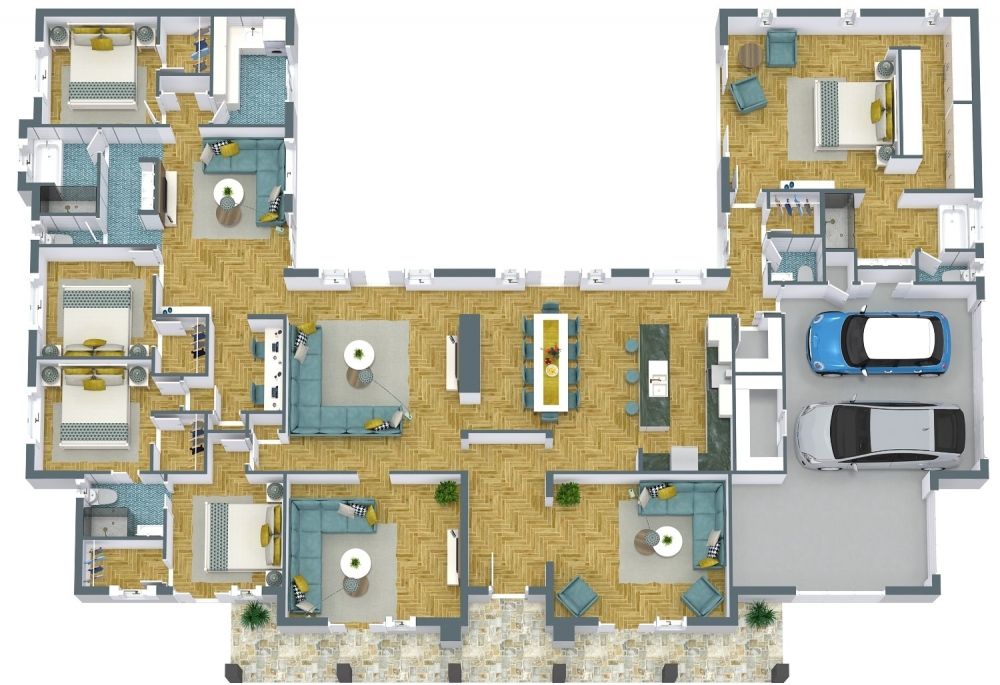One Story House Plan Examples
A one story house plan means that all the rooms are built on a single level, on the ground floor. This type of layout is great for anyone who wants to avoid stairs. But that's not the only reason that single story house plans are quite popular. Today's floor plans often have beautiful open layouts and offer many advantages. They can be easier to clean and maintain, space-efficient, quieter, more convenient, and still provide great design options.
Read More
Advantages of a One Story House Plan
Safety. One of the most obvious advantages of a one story house plan is safety. With few to no stairs, a single level home is much safer for everyone. You won't have to worry about children falling down the stairs, and in fact, anyone can trip in a distracted moment. Stairs get much harder to navigate as you age, so if you plan to remain in your home for the long term, a single level with minimal stairs is a good idea. Finally, if you ever have to evacuate your home for any reason, it's much easier if every room is on the ground floor.
Cleaning and maintenance. Have you ever lugged a heavy vacuum cleaner up a flight of stairs? Or a full load of laundry both down and back up the stairs? If so, you'll know that a single-level layout makes cleaning much easier. Even outdoor maintenance items, such as replacing window screens, cleaning outside windows, painting, or clearing out gutters are much easier and more accessible with a one story home.
Space efficient. Floor plans for single story homes are often incredibly space-efficient. For example, you don't have to use precious floor space for a set of stairs. You may be able to have fewer bathrooms as you won't have to install multiple bathrooms on each floor. Instead, one bathroom can be used for several bedrooms as well as used by any visitors. Other areas can be shared as well: rather than a mudroom or drop zone downstairs and a laundry room upstairs, you may be able to combine the two in a single story layout.
Heating and cooling benefits. One story homes tend to be easier and cheaper to heat: Since heat rises, when you have an upper floor, the heat can disappear upstairs, requiring you to run the heater for a longer time to keep the downstairs warm. In the summer, a single floor home may also stay cooler (the rising heat can overheat the top story of a multi-level home, requiring you to turn on the AC). Additionally, with just one story, you can likely have one HVAC unit, rather than one for each floor, saving you cost and maintenance.
Quieter. You won't hear the sound of anyone walking above you in a single story home. Depending on the layout you choose, you can separate the master bedroom or an in-law suite on one side of the floor plan, and the rest of the bedrooms on the other side, to further keep things quiet.
Convenience. Let's face it, with no stairs, it's likely faster to run back to your room to grab a forgotten item. If you are entering the house with a baby in a stroller, luggage, or a wheeled shopping cart, it's easier to navigate to anywhere you want to go in the house if you don’t have to face any stairs.
Accessibility. If you require a wheelchair or use a walking aid, it's much easier to move around a one story house.
More ceiling height and design options. A single level opens up lots of possibilities for interesting ceiling heights and features. High cathedral ceilings are popular and you can add them to main living areas or create a grand master bedroom. For beautiful natural light, you can place skylights virtually anywhere in a single level home.
Faster to build. It’s usually faster to construct a one story home when the builder doesn’t have to build stairs and then the additional floor above.
Compact to Luxurious
One story house plans do not have to be small. You'll find plans that range from compact to large and luxurious. If you are looking at larger one story house plans, one top tip is to look for plans that have put thought into the separate zones of the house. For example, an area for the bedrooms, a zone for entertaining, and a kitchen/eating area. This is important so that you don't have to walk halfway across the house to get from the kitchen to the dining area.